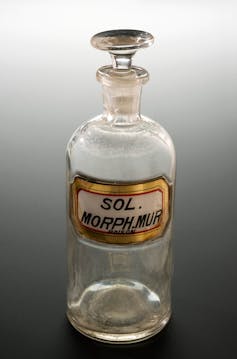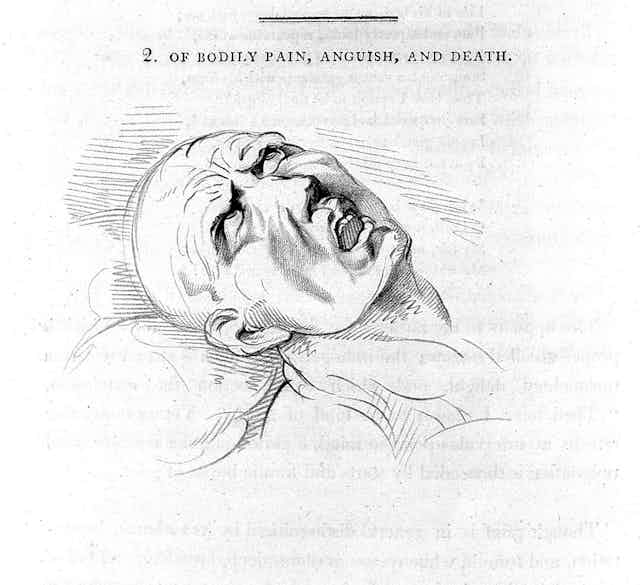“I have had little or no sleep, owing to the tooth ache or rather stump ache,” Elizabeth Drinker wrote in her diary one night in 1796. “One of my Eye teeth very sore, my face much swelled and painful.”
Drinker, a white woman from a prominent family in Philadelphia, filled her diary with comments like this. Disease was rampant in those days, and injuries often didn’t heal properly. Food was frequently spoiled, leading to painful stomach problems. Cavities and severe gum disease were common. These and other problems meant that pain – severe, intractable pain – was an ordinary part of daily life.
Of course, many people suffered far more than Elizabeth Drinker. Slaves, in particular, were forced to perform long hours of grueling work, and their injuries and illnesses were often left untreated. They also suffered from brutal physical punishment. In his 1845 autobiography, Frederick Douglass described how the overseer on his plantation whipped his aunt: “No words, no tears, no prayers, from his gory victim, seemed to move his iron heart from its bloody purpose. The louder she screamed, the harder he whipped; and where the blood ran fastest, there he whipped longest.”
It is worth considering this history in the current opiate crisis. I am a researcher who has closely studied drug use in the U.S. in the 19th century. I see many parallels between the past and today in the shameful way people of different races are treated when it comes to pain and to drug addiction.
Rise of narcotics
When Drinker was alive, people did not have many options for treating pain. The only really effective treatment was opium, taken as a tincture in an alcohol solution. Opium could dull minor and perhaps moderate pain, but if you crushed your foot in an accident, nothing could be done for your agony.
Plus, since opium also caused constipation, nausea and vomiting – all of which could be serious medical problems in their own right – people only used it in modest amounts.
Slaves were rarely given opium for their pain. Their illnesses and injuries were often left untreated. But it was also widely assumed that different types of people felt pain more or less strongly. The poor supposedly felt less pain than the rich, while men felt less pain than women and blacks felt less than whites. Physicians and slave owners therefore believed that when slaves claimed to be hurt, they were probably lying. They also believed that whippings had to be severe to be effective.
Opium was not particularly helpful for severe pain, but injected morphine was. Morphine was first isolated from opium around 1805, but it was rarely used for the next five decades, because it was difficult to tolerate when taken by mouth. In 1856, Scottish physician Alexander Wood invented the hypodermic needle. He discovered that injected morphine gives fast and highly effective relief for even excruciating pain.
Injected morphine was first widely used during the Civil War. After the war, it was used to help wounded veterans cope with their injuries, and then became a popular way to treat acute pain of all kinds.
Responses to addiction
For many people, morphine was a godsend. However, serious problems accompanied its widespread use. People began to inject morphine for recreational purposes and to escape despair. Suicide and overdoses became common. Others became addicted to morphine as well as other intoxicating drugs at the time, including cocaine and hashish.
By the end of the century, physicians were debating whether or not addiction should be considered a disease. Reformers passed the first wave of laws intended to control narcotics and other drugs. They also established treatment facilities to help people recover from their addiction.

According to historian Timothy Hickman, these efforts divided drug users into two types. People who became addicted after using morphine or other drugs to treat their pain were often described as sympathetic victims and given help. People who used drugs for recreational reasons, however, were considered “degraded” and put in prison.
In practice, of course, the difference between the two categories was often blurry. People who became addicted trying to control their pain were frequently incarcerated under the faulty assumption that their continued use was a personal choice. They were also mistaken for people who took drugs solely for recreational reasons.
There was also an important racial component to all this. After the Civil War, the widespread suffering of freed slaves was ignored by policymakers and the media as part of the effort to reunite the nation. It was also ignored by white physicians. Although statistics from the period are unreliable, it appears that blacks were prescribed morphine significantly less often than whites – in part because they received less medical care and in part because white physicians assumed that they suffered less physical pain.
Like whites, blacks sometimes used other drugs that authorities found concerning. Unlike whites, however, blacks were rarely offered sympathy or treatment for their addiction. White authorities almost always assumed that blacks used these substances for “degraded” reasons. Although whites were sometimes given sympathy and treatment even if they were considered degraded, blacks rarely were. Black addicts simply were not understood as sympathetic victims in the same way as many whites. They were seen only as dangerous criminals and often described in racist terms.
Lessons for today
Today, Americans live with the consequences of this history. We all benefit from the ability of physicians to relieve serious pain by prescribing narcotics. Yet these drugs also cause immense harm, just as injected morphine did more than a century ago. And many still have a deeply confused reaction to addiction, mistaking people who cannot control their drug habits with people who take drugs for other reasons.
The mistaken belief that blacks suffer from less physical pain than whites still persists among medical students and physicians. So does the assumption that black people are more likely to seek narcotics for supposedly illegitimate reasons. Black people receive less treatment for both acute and chronic pain than whites.
Prescription practices by physicians are only one cause for opiate addiction in this country. Illegal drug use also plays an important role in both white and black communities. Blacks use illegal drugs at roughly the same overall rate as whites, yet their rate of incarceration is three to four times higher. They also receive less effective treatment for drug addiction than whites.
The lessons here are stark. As a country, the U.S. responds to drug epidemics in very different ways depending on the skin color of the communities involved. At the same time, we have historically treated the pain of whites far more seriously than we have that of blacks. In my view, the country needs more treatment, and less prison, for people who struggle with addiction. We also need effective pain relief for everyone.

